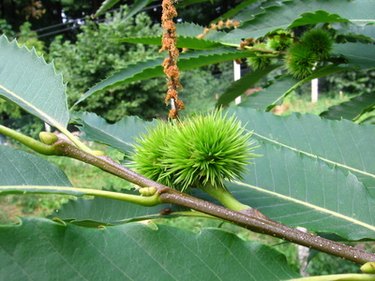
Chestnut (Castanea spp.) is a genus of tall, deciduous trees in the beech family (Fagaceae). hardy in U.S. Department of Agriculture plant hardiness zones 4 through 8, depending on the species. Chestnut trees thrive in America, Europe and Asia, all bearing large chestnut nuts which carry the same name as the tree. These nuts sprout easily in moist soil and grow quickly into large trees. If you are just sprouting a chestnut, however, you have some years to wait before roasting your own chestnuts on the open fire.
Tip
Chestnut trees bear nuts in three to 15 years, depending on the species.
Video of the Day
Planting Chestnut Trees
Chestnuts are the ruddy brown color termed "chestnut." Each chestnut tree produces both male and female flowers, but do not hope to get nuts with only one tree. The trees pollinate only with flowers from a neighboring tree.
Video of the Day
The chestnuts develop on the trees in prickly cases termed burrs. These often split open and fall to the ground when the nuts are ripe. The nuts have a shiny inner skin protecting the edible meat. All chestnut species require at least several years of growth before the trees begin to produce nuts.
European Chestnut Trees
European chestnut trees (Castanea sativa, USDA zones 5-7) grow faster and produce larger nuts -- up to several inches in diameter -- than American chestnut species. The same tree produces two kinds of nuts: chataigniers, which grow three nuts in each burr, and the larger, more valuable marrons. Each marron fills an entire burr itself. One chestnut tree can produce both kinds of nuts.
Also known as sweet chestnuts, European chestnut trees do not produce nuts until they are 15 years old. At 50 years old, they reach their peak production, though older trees are known to long produce nuts. The world's oldest sweet chestnut tree, "Castagno dei 100 cavalli," is found on Mount Etna in Sicily. Despite its estimated age of 2,000 to 4,000 years old, it still produces chestnuts.
American Chestnut Trees
A hundred years ago, American chestnut trees (Castanea dentata, zones 5-8) thrived across the United States, producing both nuts and timber. A virus accidentally introduced into the country in 1904 devastated the trees. Over the next 40 years, 3.5 billion trees died and the American chestnut became virtually extinct.
Recently, plant pathologists created a blight-resistant strain. The American Chestnut Foundation hopes to replant the chestnut forests. Trees planted today will yield nuts in three to five years.
Chinese Chestnut Trees
Asian gardeners have cultivated chestnuts for centuries. Chinese chestnuts (Castanea mollissima, zones 4-8) grow to about 40 feet tall in sunny areas. The tree requires well-draining soil and a warm climate. In ideal growing conditions, it will produce nuts in less than 10 years.
Chinese chestnuts are disease-resistant. While the chestnut blight fungus is deadly to almost all American chestnut trees, most Chinese chestnuts remain unaffected. Americans hope to improve the disease resistance of American chestnuts by crossing them with the Chinese variety.